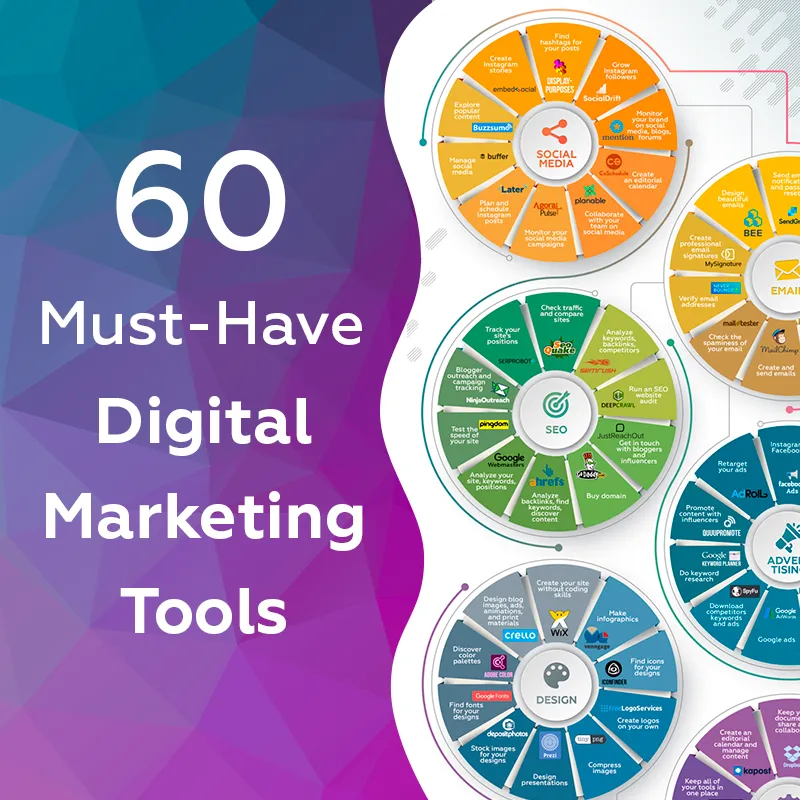What is a Competitive Analysis & How to Do It Professionally
No business operates in isolation. Every company, no matter its size or industry, has competitors. It’s common to think about them and wonder how you measure up. But beyond these thoughts, how can you analyze competitors and gain detailed insights about them? And once you complete it, what should you do with it?
Our article offers you strategies on how to conduct a competitive analysis and how to use this knowledge to make better decisions. Dive in to learn how to identify your competitors, analyze their marketing strategies, and understand their strengths and weaknesses.
What is a competitive analysis?
Competitive analysis is the process through which a company investigates its competitors to understand their strategies, strengths, and weaknesses. It’s a tool to help businesses gain competitor insights about their position within the marketplace and make informed decisions about their strategies.
Competitive analysis helps companies delve into the products and services their competitors offer, analyzing features, quality, and pricing to determine how they differ from their own. Beyond particular products, this analysis extends to analyzing marketing and sales strategies to understand how competitors reach and resonate with their target audiences.
However, competitive analysis isn’t solely about what your competitors are doing. It’s also about identifying gaps in the market, finding opportunities for differentiation, and predicting potential threats. By understanding your competitors’ operational structures, technological investments, market positions, and even legal and regulatory systems, you can craft strategies that are more competitive and innovative.

What is included in a competitive analysis report?
- Competitor identification. Сategorizing main competitors as direct, indirect, or perceived, based on the nature of their products and relevance to your offerings.
- Product overview. A detailed exploration of competitor product ranges, features, quality, and pricing.
- Market position. Determining each competitor’s place in the market, such as their market share, reputation, and influence within the industry.
- Marketing and sales tactics. Analysis of the promotional channels and techniques used by your competitors.
- Pricing strategies. Understanding the pricing models and structures that your competitors adopt for their products.
- Financial insights. An examination of available financial data to understand the economic strength, profitability, and growth trajectories of your competitors.
- Operational structure. Insight into business operations, such as supply chain mechanisms, distribution networks, and partner collaborations.
- Customer perception. Analyzing how customers view and react to competitors, which can be seen from reviews, feedback, and other public interactions.
- Digital footprint. Assessing the reach of your competitors’ online presence, such as websites, blogs, social media profiles, and digital campaigns.
- SWOT analysis. A systematic evaluation of competitor Strengths, Weaknesses, Opportunities, and Threats, based on all the collected data.
Why is competitive analysis important to an entrepreneur?
First and foremost, competitor analysis gives you insight on who the major players in the industry are and what their strategies, strengths, and weaknesses are. By recognizing where your competition stands, you can better discern your position and make more informed decisions. This helps you to leverage your unique selling proposition and find ways to differentiate yourself. Conversely, by identifying competitor weaknesses, you can exploit these gaps and carve out a competitive advantage.
Furthermore, competitor analysis shows market trends and shifts, so you can anticipate industry trajectories and be proactive rather than reactive. But the insights from competitor analysis aren’t just about offense; they’re also about defense. Understanding competitors means being alert to potential threats. If a rival is preparing for an aggressive market expansion or launching a revolutionary product, being warned about it allows a company to strategize accordingly. It can also help you discover areas of improvement, so you can continuously learn and adapt to not only match your competitors, but also surpass them.

When should you do a competitor analysis?
- With launching. If your own company is going for a new product launch, a competitive analysis shows you how to position yourself to improve your launch strategy. This ensures that your product has unique selling points or addresses gaps that competitors might have overlooked.
- Entering new markets. If a company is planning to expand geographically or dive into a new segment, a competitive market analysis can offer insights into local competitors, market demands, and potential challenges.
- Annual business review. Just as businesses often conduct yearly financial audits, a regular competitive analysis framework should be part of annual strategic reviews to make sure you remain updated on market shifts and competitor activity.
- Post significant industry changes. After technological advancements, regulatory changes, or market disruptions, it’s essential to reevaluate competition, as such shifts can change the competitive landscape.
- Before major campaigns. When planning a significant marketing campaign, understanding competitive analysis in marketing can help in crafting messages that stand out and resonate more effectively with your target audience.
- Mergers and acquisitions. If your company is considering merging or acquiring another business, a deep competitor analysis can provide you with insight into how this move might affect the competitive balance.
- Facing business stagnation. If your sales decline, it might be time to reevaluate competitors to discern if this is due to increased competitive activity or if there are gaps in your offerings.
- Customer feedback. If a significant number of customers begin comparing your products with a competitor, it indicates the need for a fresh market competition analysis to understand evolving market perceptions.
What is the difference between market research and competitive analysis?
Market research and competitive analysis seem similar at first glance, but they differ in their focus. As previously discussed, competitive analysis is the process of evaluating your competitors, understanding their strategies, strengths, and weaknesses. It seeks to comprehend how your business compares to others in the same market space. It’s usually used when entering new markets, launching new products, or formulating business strategies. Techniques of competitive analysis might include competitor research, product comparisons, and studying marketing strategies. The insights from a competitive analysis help businesses identify gaps in the market, potential threats, areas for differentiation, and opportunities for growth. It addresses questions like who are the main competitors? What strategies do they use? How does their product compare to yours?
On the other hand, market research is a comprehensive study of potential customers, their preferences, behaviors, and needs within a particular market. It aims to understand the market and identify opportunities or challenges within. It’s often used during product development, market entry, or when identifying new opportunities within existing markets. Common methodologies of market research include surveys, focus groups, and observational studies. As a result, you gain insights on product demand, optimal pricing strategies, promotional tactics, and potential market segments. Market research can also reveal market size, growth potential, and trends. It aims to answer such questions as: Who are the potential customers? What do they want? How do they behave?
To put it simply, market research is more externally focused on customers and the broader market, while competitive analysis is more focused on rival businesses. Together, they provide a 360-degree view of the business environment to help you navigate the market more effectively.

What are the types of competitor analysis?
1. Direct competitor analysis
Direct competitor analysis focuses on businesses that offer the same or very similar products as yours, targeting the same customer base. It’s about understanding companies that your target audience might choose instead of your offerings.
2. Indirect competitor analysis
Indirect competitors may offer different products, but solve the same problem or fulfill the same need for your target audience. While they might not be in the exact same category as your business, they’re competing for the same customer.
3. Perceived competitor analysis
These are businesses that aren’t necessarily in the same industry or category, but are perceived as alternatives by your target audience. For instance, a gym might perceive a home workout app as a competitor, especially in the digital age.
4. SEO competitor analysis
SEO competitor analysis emphasizes competitors that rank for the same keywords as you do on search engines. Understanding how to analyze competitors in the digital space can help you refine your SEO strategy to improve online visibility.
5. Product analysis
It’s an analysis of specific products offered by competitors. This type of analysis looks at features, benefits, pricing, quality, and any other attributes that differentiate one product or service from another.
How do you conduct a competitive analysis?
1. Identify your competitors
List your primary competitors. You can identify them through online research, industry reports, and customer feedback. They can be broadly categorized into several types:
- Direct competitors: offering similar products or services targeting the same audience.
- Indirect competitors: satisfy the same need or problem as your product.
- Emerging competitors: new companies in the market that might not be on your radar yet, but have the potential to grow.
2. Determine objectives
Before diving deep, you need to know the aim of your analysis to guide your research. Your potential objectives might include:
- Understanding the competitive landscape and market dynamics.
- Identifying gaps in the market
- Anticipating market trends
- Understanding promotional strategies of competitors
- Informing your product development

3. Analyze competitor products
Examine the range of products your competitors offer, how their quality compares to yours, and what features they highlight. This will help you understand what sets your offerings apart. Here’s what you should look at specifically:
- Features and specifications. Begin by comparing different aspects of the products. What features do they offer? How do these features compare with yours? Look for any innovative aspects that stand out.
- Quality and durability. It’s not just about what the product does, but how well it does it. Get your hands on the product if possible and determine its longevity and reliability.
- User experience. This aspect is specially relevant for software products. How intuitive is a competitor’s product? Is it user-friendly? Are there any recurring complaints from their users?
- Product variety. Sometimes, it’s not just about a single product, but the range of options available. Think about whether your competitors offer more variety or customizable options.
4. Study marketing strategies
Dive into websites, social media profiles, advertising campaigns, and other promotional activities of your competitors. Understand how they position themselves and what messaging they use to get insights on their target audience, market positioning, and potential pain points. It’s equally essential to assess their presence across various media and dive into their SEO efforts to understand how they are usually discovered online. Here’s what you should look at in particular:
- Advertising channels
- Content strategy
- Social media presence
- SEO and online visibility
- Events and/or webinars
5. Evaluate pricing
Understand how your competitors price their products or services. Are they aiming for a premium market segment, or are they competing on price? Start by simply listing out the prices of comparable products. Are they priced higher or lower than yours? What might be the reason for this? Higher prices might be justified with premium features, better quality, or brand reputation. Conversely, lower prices might indicate a budget or entry-level positioning in the market.
Check if they have regular discounts or special offers and take note of any loyalty programs or purchase deals. Determine if the pricing is a one-off fee, a subscription model, freemium, or something else. Each model attracts a different kind of customer and has its own pros and cons. Sometimes, the initial price isn’t the whole story. Are there any additional fees, maintenance costs, or upsells that customers should be aware of?
6. Understand distribution channels
How do your competitors get their products to customers? Do they use e-commerce, physical storefronts, distributors, or a combination? If they use e-commerce for distribution, do they host their own platforms, rely on third-party giants, or mix both? Some businesses may opt for direct-to-consumer methods, bypassing traditional retail. Others might prioritize their presence in major stores.
Additionally, find out if they have a local, national, or international distribution strategy. A company’s reach speaks volumes about their ambitions and logistical prowess. Understanding these processes is not just about gauging competitors, but also about finding opportunities to expand or streamline your own distribution methods.

7. Formulate your strategy
Based on your findings, develop or refine your own strategy. Use insights to find gaps in the market or areas where competitors are underperforming. Apply the data to fuel innovation in product development, customer service, and distribution methods. If a competitor is offering something unique, think of how you can provide added value to your customers. If certain marketing channels are over or under crowded, consider reallocating your budget or trying new approaches.
8. Stay updated
Competitor analysis isn’t a one-time activity. Markets evolve and competitors change their strategies. Set up Google Alerts for competitor names, subscribe to their newsletters, and regularly revisit your analysis to stay updated. You need to be aware of any new product launches, changes in marketing strategies, shifts in target demographics, or mergers and acquisitions. This enables you to proactively adjust your strategies, ensuring you remain at the forefront of market competition.
To wrap up
Conducting a competitive analysis isn’t just about knowing who your competitors are, but about understanding their operations, strategies, strengths, and weaknesses. This provides you with valuable insights that can help you make better decisions. Through competitor research, you can strengthen your strategies, find new opportunities, and prepare for challenges. This ensures you remain informed and ready for the future.
Competitive analysis FAQs
What is a competitive analysis report?
A competitive analysis report is a comprehensive document that outlines your understanding of your competitors. It evaluates their strengths, weaknesses, strategies, products, services, marketing techniques, and more. This report shows the competitive landscape, helping you understand your position within the market and identify areas for improvement.
Is competitor analysis the same as SWOT analysis?
No, they are not the same, but are closely related. Competitor analysis focuses specifically on understanding and analyzing competitors in the market, while SWOT analysis is a broader strategic tool that evaluates your own Strengths, Weaknesses, Opportunities, and Threats. Competitor analysis can incorporate insights from a SWOT analysis, but they serve different primary purposes.
How often should you perform a competitive analysis?
Ideally, businesses should conduct a basic competitive analysis regularly, perhaps quarterly or bi-annually, while a more in-depth analysis can be performed annually. The frequency can also depend on the industry’s pace, because for rapidly evolving sectors like technology, more frequent analyses might be beneficial. Additionally, specific events like a major competitor launching a new product or entering new markets might demand a competitive analysis.
Does market research include competitive analysis?
While both are essential components of strategic business planning, they are different. Market research is broader and focuses on understanding the market’s size, growth, demographics, trends, customer preferences, and more. Competitive analysis, as a part of market research, specifically focuses on competitors and their strategies. So, competitive analysis can be a subset of market research, but not all market research activities can be labeled as competitive analysis.
Other articles you might find interesting
Reputation Management: How to Protect Your Brand
Crafting Your Mission Statement: Best Examples & Ready-to-Use Free Templates
Leadership Styles Demystified: Finding Your Path to Success
10 Best Data Visualization Tools and Techniques in 2023
Creating a Marketing Plan: Steps, Types & Expert Tips









